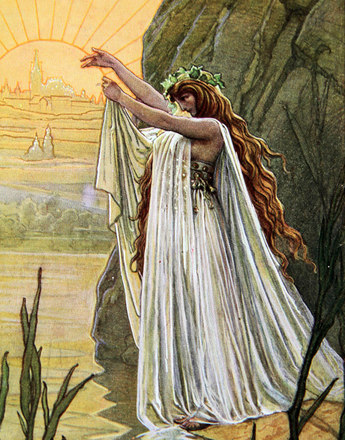In spite of the numbers – according to the 1910 census, 6.4 per cent of the population of Austria-Hungary belonged to the Romanian language group – the Romanians were an underprivileged nation.
Deșteaptă-te, române, din somnul cel de moarte,
În care te-adânciră barbarii de tirani!
Acum ori niciodată croiește-ți altă soartă,
La care să se-nchine și cruzii tăi dușmani!
English translation:
Wake up, Romanian, from the sleep of death
Into which you have been sunk by the barbaric tyrants!
Now, or never, make a new fate for yourself
To which even your cruel enemies will bow
The melody and lyrics were written as a fighting song during the 1848 revolution. The song has been the official national anthem of Romania since 1989.
The Romanian settlement areas in the Habsburg Monarchy were concentrated in Transleithania, primarily in Transylvania, a region in the east of the historical Kingdom of Hungary. There were also Romanian-speaking settlements in the Banat and in the east of the Hungarian Plain, where Romanians had colonized areas devastated during the Turkish wars.
Within the entire Kingdom of Hungary, there were around 3.5 million Romanian speakers in 1910, representing 16.1 per cent of the population of the Hungarian half of the empire. In Cisleithania there were 300,000 Romanians in Bukovina, accounting for 34.4 per cent of the population of this crown land and making them the second-largest language group after the Ruthenians.
An important aspect of the emergence of a Romanian nation was the fact that they did not live only in the Habsburg Monarchy. The greater part of this south-east European language group lived in the historical principalities of Wallachia and Moldova, two regions that in the early modern era belonged to the Ottoman Empire. It was here that the development of the Romanian nation state began, when these territories were emancipated from Turkish control in the nineteenth century, a process culminating in the formation of the Principality of Romania in 1859/61. The existence of a sovereign nation state gave impetus to the irredentism of the Romanian-speaking minorities in the Habsburg Monarchy, who saw the new state as a protector and a support for their national awareness.
Compared with other ethnic groups, the Romanians under Habsburg rule were slow in moving towards nationhood. Known historically as Wallachians, they were regarded as a ‘peasant people’ without a history as they lived under the social and economic hegemony of other language groups. Significantly, the Romanians in Transylvania were not represented in parliament in the early modern era. The historical constitution gave a voice only to the Magyars, Székelys and Saxons. This pre-modern interpretation of ‘natio’ saw it merely as a legal community with only a vague reference to the ethnic or linguistic context, whereas in the nationalist movements of the nineteenth century it was interpreted ahistorically as a linguistic concept.
The emergence of the Romanian nation was thus linked from the outset with social demands and took the form of an emancipation process from feudal and national repression. In the historical awareness of a large mass of Romanians, rebels against the Hungarian landowners and authority were the national heroes.
The initial spark for political emancipation came during the 1848 revolution at the national assembly in Blasendorf [Blaj] in Transylvania, where national demands were formulated for the first time by a committee representing the people. As a first step it demanded representation in the various parliaments commensurate with the population. The long-term aim was to bring together all Romanian settlement areas in Hungary, Transylvania and Bukovina to form an independent crown land. Betterment of the social status was also demanded, in view of the exclusion of Transylvania from the reforms by Emperor Joseph II and the continued existence of the remnants of serfdom there.
The Romanian envoys who turned to the Vienna court with their demands were referred to the Hungarian parliament, which – fixed on the idea of a Hungarian nation state – simply ignored the Romanian concerns.
As a consequence, the representatives of the Romanians did not rally behind the Hungarian Magyar national programme during the Hungarian revolution and freedom struggle in 1848/9. On the contrary, the Wallachians saw the Emperor in far-off Vienna as their patron in the fight against Magyar supremacy and participated in putting down the Hungarian separatist movement. This action took the form in particular of local uprisings against the Hungarian landowners, once again out of an explosive mixture of national and social motives.
The loyalty appeared to pay off. In return, Vienna – particularly, however, in order to weaken the Magyar position – made Transylvania a crown land in its own right, albeit still as part of the Kingdom of Hungary in which the Romanians were in a majority, but now with representation in parliament.
Translation: Nick Somers
Hanák, Péter: Die Geschichte Ungarns. Von den Anfängen bis zur Gegenwart, Essen 1988
Hitchins, Keith: Die Rumänen, in: Wandruszka, Adam/Urbanitsch, Peter (Hrsg.): Die Habsburgermonarchie 1848–1918, Band III: Die Völker des Reiches, Wien 1980, Teilband 1, 585–625
Hösch, Edgar: Geschichte der Balkanländer. Von der Frühzeit bis zur Gegenwart, München 1999
Kahl, Thede: Rumänien. Band 1: Raum und Bevölkerung. Geschichte und Geschichtsbilder (= Österreichische Osthefte 48), Wien 2008
Rumpler, Helmut: Eine Chance für Mitteleuropa. Bürgerliche Emanzipation und Staatsverfall in der Habsburgermonarchie [Österreichische Geschichte 1804–1914, hrsg. von Herwig Wolfram], Wien 2005



